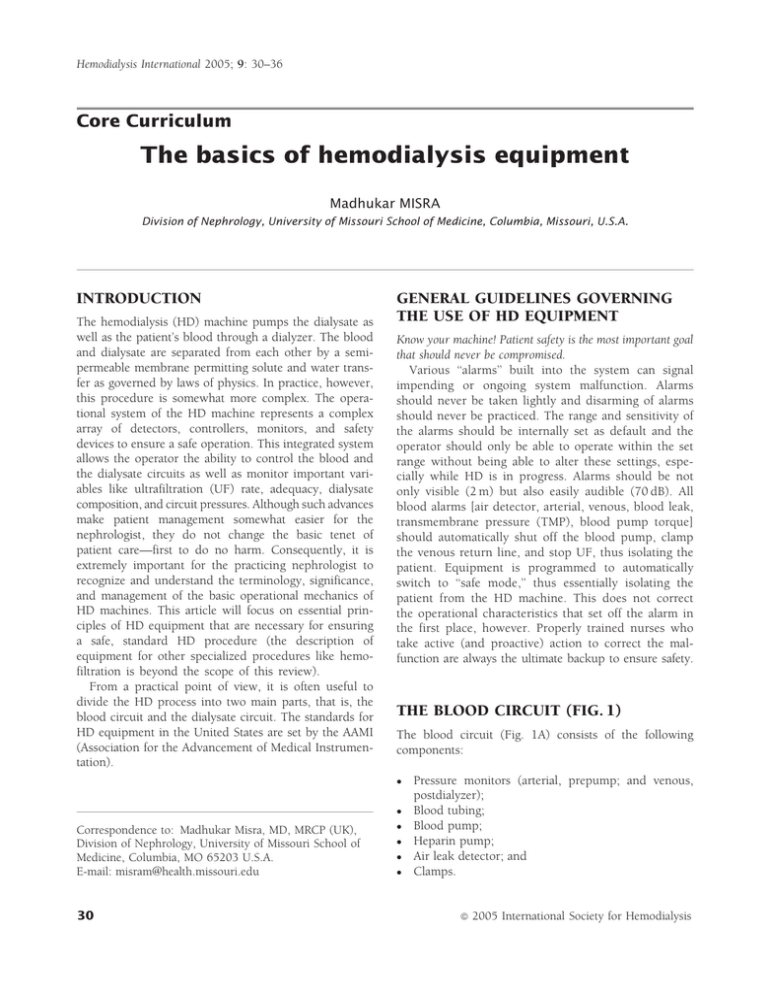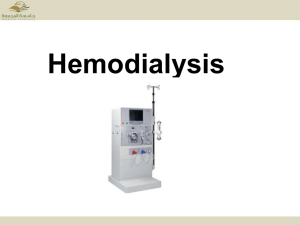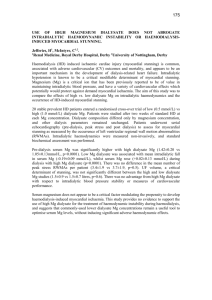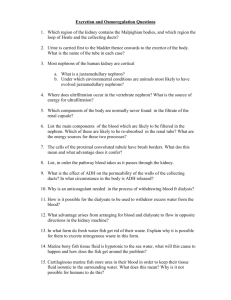
Hemodialysis International 2005; 9: 30–36
Core Curriculum
The basics of hemodialysis equipment
Madhukar MISRA
Division of Nephrology, University of Missouri School of Medicine, Columbia, Missouri, U.S.A.
INTRODUCTION
The hemodialysis (HD) machine pumps the dialysate as
well as the patient’s blood through a dialyzer. The blood
and dialysate are separated from each other by a semipermeable membrane permitting solute and water transfer as governed by laws of physics. In practice, however,
this procedure is somewhat more complex. The operational system of the HD machine represents a complex
array of detectors, controllers, monitors, and safety
devices to ensure a safe operation. This integrated system
allows the operator the ability to control the blood and
the dialysate circuits as well as monitor important variables like ultrafiltration (UF) rate, adequacy, dialysate
composition, and circuit pressures. Although such advances
make patient management somewhat easier for the
nephrologist, they do not change the basic tenet of
patient care—first to do no harm. Consequently, it is
extremely important for the practicing nephrologist to
recognize and understand the terminology, significance,
and management of the basic operational mechanics of
HD machines. This article will focus on essential principles of HD equipment that are necessary for ensuring
a safe, standard HD procedure (the description of
equipment for other specialized procedures like hemofiltration is beyond the scope of this review).
From a practical point of view, it is often useful to
divide the HD process into two main parts, that is, the
blood circuit and the dialysate circuit. The standards for
HD equipment in the United States are set by the AAMI
(Association for the Advancement of Medical Instrumentation).
GENERAL GUIDELINES GOVERNING
THE USE OF HD EQUIPMENT
Know your machine! Patient safety is the most important goal
that should never be compromised.
Various ‘‘alarms’’ built into the system can signal
impending or ongoing system malfunction. Alarms
should never be taken lightly and disarming of alarms
should never be practiced. The range and sensitivity of
the alarms should be internally set as default and the
operator should only be able to operate within the set
range without being able to alter these settings, especially while HD is in progress. Alarms should be not
only visible (2 m) but also easily audible (70 dB). All
blood alarms [air detector, arterial, venous, blood leak,
transmembrane pressure (TMP), blood pump torque]
should automatically shut off the blood pump, clamp
the venous return line, and stop UF, thus isolating the
patient. Equipment is programmed to automatically
switch to ‘‘safe mode,’’ thus essentially isolating the
patient from the HD machine. This does not correct
the operational characteristics that set off the alarm in
the first place, however. Properly trained nurses who
take active (and proactive) action to correct the malfunction are always the ultimate backup to ensure safety.
THE BLOOD CIRCUIT (FIG. 1)
The blood circuit (Fig. 1A) consists of the following
components:
Correspondence to: Madhukar Misra, MD, MRCP (UK),
Division of Nephrology, University of Missouri School of
Medicine, Columbia, MO 65203 U.S.A.
E-mail: misram@health.missouri.edu
30
Pressure monitors (arterial, prepump; and venous,
postdialyzer);
Blood tubing;
Blood pump;
Heparin pump;
Air leak detector; and
Clamps.
ª
2005 International Society for Hemodialysis
Basics of hemodialysis equipment
BLOOD CIRCUIT
Pressure
“Venous”
Arterial
needle
“Arterial”
+
Venous pressure
monitor
200
0
Heparin
–
Arterial
pressure
monitor
A
Dialyzer
Air
detector
Blood
pump
Arterial
blood
lines
Automatic
clamp
B
Blood
pump
Dialyzer
Venous blood line
Figure 1 (A) The blood circuit. (B) The pressure profile in the blood circuit with an arteriovenous fistula as the blood access. (If
a central venous access is used, the pressure profile will reflect the central venous pressures that are close to 0 or even slightly
negative.) Reprinted by permission of Mayo Foundation for Medical Education and Research. All rights reserved.
Arterial pressure monitor (prepump)
Venous pressure monitor (postdialyer)
This component monitors the pressure between the blood
access and the blood pump. The pressure is negative
between the access and the blood pump (Fig. 1B) but
achieves a high positive range post-blood pump
(Fig. 1B). The pressure transducer signal is amplified
and converted to an electrical signal. Alarms may indicate
patient disconnection, separation of blood tubing, or
obstruction/kink in the blood circuit. The normal pressure reading in this segment of the blood circuit is negative (subatmospheric). Negative pressure makes this
segment prone to entry of air into the bloodstream.
Longer needles with smaller bores increase negative pressure readings in this segment. Likewise, negative-pressure
augmentation may be seen when longer catheters with
smaller internal diameter bores are used, especially with
higher blood flows. Out-of-range pressures trigger the
machine to clamp the blood line and activate the appropriate alarms.
The venous pressure may build up owing to resistance to
venous return anywhere between the venous drip chamber
and the venous needle (together with the access pressure).
Venous pressure monitors normally read positive pressures. Out-of-range pressures trigger clamping of the
blood line, stopping of the blood pump, and activation of
appropriate alarms, with shutting of the venous return.
Causes of a low venous pressure alarm
Disruption of connections anywhere downstream
from the blood pump to and including the venous
needle and access; and
Low blood flow (upstream of blood pump).
Causes of a high venous pressure alarm (high venous
pressure may rupture the dialyzer membrane!)
Kink in the venous return line;
Clot in the venous drip chamber; and
Venous access malfunction.
Causes of low arterial pressure alarm
Fall in blood pressure;
Kink between needle and pump;
Clot (check for air bubbles); and
Suction of vessel wall into the needle.
Causes of a high arterial pressure alarm
Increase in patient’s blood pressure;
Circuit disruption between access and pump;
Unclamping of saline infusion line; and
Blood pump that has torn the pumping segment
(check for blood leak).
Hemodialysis International 2005; 9: 30–36
Blood tubing
Blood tubing is made of biocompatible and nontoxic
material. The blood tubing in the pump segment is treated with silicone to minimize blood clotting. Because of
its high cost, the use of silicone-treated blood tubing in
single-use systems is uncommon. Leaching of phthalate
di-(2-ethylhexyl) phthalate (DEHP) from polyvinyl chloride (PVC), a constituent of the blood tubing, may occur
into the blood circulation and lead to liver damage.
Phthalate may very rarely lead to anaphylaxis.
31
Misra
Blood pump
Blood is pumped in the circuit by peristaltic action at a
rate of 200 to 600 mL/min. The pump usually has two
rollers (roller rotation compresses the tubing, thus forcing
blood along the tube), operating on a low-voltage motor
(less electrical hazard). The blood pump is spring-loaded
to prevent under-/overocclusion of the blood tubing
(the pump segment of the tubing is made up of thicker
and more resilient material). The pump is adaptable to
different sized tubing if indicated clinically and can be
operated manually in the event of a power loss. It is
calibrated to measure blood flow rate (BFR) depending
on the internal diameter of the tubing:
BFR ¼ rpm ðmeasured directlyÞ
tubing volume ðPi r2 1Þ;
where r is the internal radius of the tubing and l is the
length of the tubing being compressed between the two
rollers. Owing to limited rigidity, the tubing between the
two rollers flattens with a high negative pressure and the
above formula overestimates the blood flow at high BFR.
Heparin pump
The heparin pump is commonly a syringe pump,
although a roller pump may be used. Heparin is infused
downstream into the positive-pressure segment of the
blood circuit (post-blood pump, predialyzer). If infused
prepump in the negative-pressure segment, the risk of air
embolism is enhanced.
Air leak detector
The air leak detector is one of the most important features
of a HD machine. It is placed distally in the venous blood
line and monitors for and prevents air embolus (incidence of major air embolus is approximately in 1:2000
treatments). The usual volume of air needed to result in
this complication is 60 to 125 mL (1 mL/kg/min, may
vary), especially if rapidly injected. The air presents as
foam with microbubbles.
Requirements for air detector
Should preferably be ultrasound (US)-based (detects
change in US frequency caused by air foam).
Should respond to air in blood, blood and saline, or
saline alone. Because fluids transmit sound more
efficiently, a drop in the intensity of US indicates
presence of air bubbles (rate of transmission of
US: blood > saline > air).
Must activate alarm and stop pump.
Must activate venous line clamp capable of complete
occlusion of blood return line to 800 mmHg (highcompliance dialyzers will ‘‘squeeze’’ blood into the
blood circuit even with the pump stopped).
Should not be oversensitive (to prevent unnecessary
alarms).
Blood tubing clamps
The blood tubing clamps should be able to withstand
pressures up to 800 mmHg. They should automatically
shut if the circuit is broken or electrical power is lost (it
should be possible to open them manually if power is lost).
THE DIALYSATE CIRCUIT (FIG. 2)
Present-day machines employ single-pass systems that
discard the spent dialysate once it circulates through the
dialyzer. The delivery of safe dialysate involves careful
regulation of its temperature, concentration, flow, pressure, as well as its proper disinfection and/or cleaning.
The key components/processes of this circuit include:
Heating;
Deaeration;
Proportioning;
Monitoring;
UF; and
Disinfection;
The mixing (proportioning) of the dialysate and bicarbonate with pure water may be done by individual
machines or centrally. In the latter instance, the premixed
dialysate is then delivered to individual dialysis machines.
Likely points of air entry
Arterial needle;
Prepump arterial tubing segment;
Open venous catheter; and
Empty bags and infusion sets.
32
Heating of the dialysate
In most machines, heating increases the temperature of
the incoming water (not the dialysate) to body temperature and degasses cold water. It also improves mixing
Hemodialysis International 2005; 9: 30–36
Basics of hemodialysis equipment
DIALYSATE PATHWAY
Acid/acetate
mixing
Bicarbonate
mixing
Deaerator
unit
Heat
exchanger
Filter
Filter
Filter
Treated
water
Heater
HCO3–
concentrate
Conductivity
cell
Acid/acetate
concentrate
Temperature
monitor
Dialyzer
Pump
14.0
Drain
Dialysate
pressure
pH probe
Conductivity
display
Blood
leak
detector
Flow meter
Bypass
Figure 2 The dialysate circuit. Reprinted by permission of Mayo Foundation for Medical Education and Research. All rights
reserved.
with the dialysate concentrate. Its heating elements need
to be made of stainless steel (not copper or aluminum).
Internal controls (preset) should limit the temperature
range to 33 to 39 C (92–102 F). This function is monitored downstream by the dialysate temperature control
monitor in the dialysate circuit.
Acid-chloride salts of Na, K, Ca, Mg, and acetate; and
Bicarbonate-sodium bicarbonate and sodium chloride.
Bicarbonate is made fresh, because preprepared bicarbonate may slowly release CO2 into the air and supports
bacterial growth.
Potential proportioning problems
Dialysate deaeration
Deaeration (degassing) prevents potential problems caused
by air dissolved in the water of the dialysate solution. Air
may cause flow problems in the dialyzer (air locking). It
may also cause alterations in UF by affecting the TMP in
addition to affecting the function of various monitors.
Water is heated to physiologic temperatures and then subjected to negative pressure, thus venting any released air.
The negative pressure is achieved by a ‘‘constricting valve’’
situated upstream of the pump that circulates water in a
closed loop containing an air trap and vent (Fig. 3). Alternatively, deaeration may be accomplished by heating the
water to 85 C followed by cooling before proportioning.
Electrolyte abnormalities attributed to proportioning
problems
High
High
High
High
Dialysate proportioning
Dialysate proportioning ensures proper mixing of heated
and treated water with one or more streams of dialysate
concentrate (see later) to prepare a dialysate of correct
proportion, temperature, and conductivity within specific
physiologic limits. This is accomplished by means of
proportioning pumps and concentrates:
Hemodialysis International 2005; 9: 30–36
Wrong concentrate [note color coding of lines, redacid, and blue-base—different concentration attributed to different manufacturers (Fresenius acid 34:1,
Cobe acid 44:1)];
Poor mixing;
Clogged filters;
Crystallization in the system; and
Human disarming of switches.
or low plasma sodium;
or low plasma osmolality;
or low plasma potassium; and
calcium/magnesium.
Clinical problems related to dialysate water
Hemolysis (copper may leach from cuprophane or
from the heating element. Currently, cuprophane
33
Misra
DEAERATED H2O OUT
AIR VENT
PRESSURE
REGULATOR
HEATED H2O IN
AIR TRAP OR
COALESCING FILTER
NEGATIVE
PRESSURE
PUMP
Figure 3 Dialysate deaeration. Copyrighted material, Monash University (www.ecse.monash.edu.au/ucourses/ECE 3802).
dialyzers are sparingly used in the developed world
and heating elements are made of stainless steel).
Hemolysis (nitrates and chloramine).
Ventricular tachycardia, pruritus (although fluoride
has not been a constituent of water for the past two
to three decades).
Monitoring of the dialysate circuit
pH
This monitors the ratio of HCO3– to H2CO3 (pH) of the
dialysate. The recommended pH range is 6.8 to 7.6. Not
all machines come equipped with a pH monitor.
Temperature monitor
The temperature monitor is a heat sensor that monitors
the dialysate temperature near the dialyzer; it should have
a short feedback loop to the heater element to allow quick
adjustment of the temperature ( 0.5 C). The usual
recommended temperature range is 35 to 42 C. Colder
dialysate temperatures are used to prevent hypotensive
episodes during HD. When the monitor alarms, the dialysate is automatically diverted to the drain.
Cold dialysate may cause shivering.
Warm dialysate (> 42 C) may cause protein denaturation.
Warmer dialysate (> 45 C) may cause hemolysis.
Conductivity
The conductivity monitors must be made of high-quality
corrosion resistant material. The ionic constituents of the
34
dialysate determine its conductivity. Conductivity monitoring ensures proper water:concentrate ratio of the dialysate. The units of conductivity are millisiemens per
centimeter. The normal range is 12 to 16 mS/cm; high
and low alarm settings should be within 5% of the
sensitivity settings. External readjustment of the alarm
settings by machine operators can lead to extremely
risky and dangerous situations. Conductivity can be
affected by temperature or acetate:chloride or chloride:bicarbonate ratio.
Measurement of conductivity
The conductivity sensor consists of two metal electrodes
that are exactly 1 cm apart and protrude into water. A
constant voltage is applied between the two electrodes.
An electrical current flows through the water owing to
this voltage and is proportional to the concentration of
the dissolved ions in the water—the greater the number
of ions, the more conductive the water (or lesser the
resistance/impedance), resulting in a higher current that
is measured electronically. Because the electrical current
flow increases with increasing temperature, the electrical
conductivity values are automatically corrected to a standard value of 25 C. The values are then technically
referred to as specific electrical conductivity. The conductivity output signal is adjusted for temperature
changes by an attached thermistor (Fig. 4). It is mandatory to regularly check the functioning of conductivity
meters by formal analysis of the dialysate sodium concentration (e.g., by direct or indirect ion-selective electrode method or by flame photometry. Unfortunately,
these methods too, are subject to a high error rate
owing to problems with standardization). The alarm
Hemodialysis International 2005; 9: 30–36
Basics of hemodialysis equipment
METER WITH
ALARM SETTINGS
CIRCUITRY
+
CURRENT SOURCE
e–
–
+
e–
THERMISTOR
DIALYSATE
CONDUCTIVITY CELL
Figure 4 Dialysate conductivity measurement. Copyrighted material, Monash University (www.ecse.monash.edu.au/ucourses/
ECE 3802).
points should be such that they cannot be changed.
(sodium 120–160 m eq/L)
Management of dialysate alarms
Alarms should interrupt the supply of dialysate to the
dialyzer: check for ‘‘no flow’’ in the flow meter and no
dialysate stream at the dialyzer:
Is the concentrate container empty?
Is the concentrate line connector plugged in?
Is the water inlet pressure normal?
Are there any water leaks and/or puddles beneath the
mixing chambers?
Never adjust conductivity settings while the patient is connected to the dialysis machine!
Dialysate pressure, pump, and UF control
Dialysate pressure is monitored similar to monitoring of
pressure in the blood circuit.
Pressure monitors
The pressure range is 400 to þ350 mmHg with an
accuracy 10%; alarm limits are set at 10% of the
pressure setting. Dialysate side positive pressure should
not exceed blood compartment pressure (risk of blood
contamination by unsterile dialysate following membrane
rupture and backfiltration). Some backfiltration, however, is common with high blood flow rates and dialyzers
with long fiber length. UF is controlled by TMP.
TMP ¼ PBO PDO (the pressure difference at the blood
and dialysate outlets). TMP is adjusted to achieve the
desired rate of UF, as low as 50 mL/hr. Modern volu-
Hemodialysis International 2005; 9: 30–36
metric dialysis machines achieve the desired UF based
on flow sensor systems (inflow and outflow) that measure
the pre- and postdialyzer flow rates (the difference is the
UF rate) (Fig. 5A) or by matching the dialysate inflow and
outflow rates (a separate pump is available for UF)
(Fig. 5B). By keeping the pumps out of sequence, the
dialysate keeps flowing continuously.
Blood leak monitoring
The blood leak monitor allows detection of blood leaks
and prevention of dialysate contamination by blood
downstream of the dialyzer. The monitor (infrared or
photo detector) has a ‘‘flow-through’’ configuration (sensor is at the bottom, and therefore, air bubbles do not
interfere) (Fig. 6). Red blood cells present in the dialysate
scatter light. The monitor operates by looking for loss of
transparency when light is passed through the dialysate
column (postdialyzer). Loss of sensitivity may occur
owing to biofilm, deposits, or clots. The sensitivity of
monitor is 0.25 of 0.35 mL of blood per liter of dialysate.
Monitor triggers visual and audible alarms, immediately
deactivating blood pump.
Dialysate disinfection and rinsing
All parts of the dialysate circuit should be exposed to the
disinfectant. Adequate time for disinfection ensures adequate bacterial killing. The machine should be in bypass
mode during disinfection with dialysate alarms overridden. The blood pump power supply should be off as a
safeguard. The effluent dialysate line should be isolated
from the drain with an air break to prevent backflow and
siphoning. Heat during disinfection might caramelize
35
Misra
Transmembrane
pressure
(TMP)
adjustment
ULTRAFILTRATION CONTROL
Analyzer
Inflow
Sensor
Dialysate+
ultrafiltrate
Outflow
sensor
ULTRAFILTRATION CONTROL
Fresh
dialysate
Balanced “pumps”
(chambers)
Drain
Outflow
pump
Inflow
pump
Open clamps
Dialyzer
A
Drain
Fresh
dialysate
Dialyzer
B
Closed clamps
Dialysate
pump
Drain
Used
dialysate +
ultrafiltrate
UF pump
Figure 5 Ultrafiltration: (A) flow sensor–based; (B) volumetric balancing–based. Reprinted by permission of Mayo Foundation
for Medical Education and Research. All rights reserved.
dextrose causing malfunction of blood leak detectors and
obstruction of valves.
Dialyzer disinfectants and rinse solutions
Dialyzer disinfectants and rinse solutions include formaldehyde, hypochlorite (bleach), and peracetic acid.
Always rinse the machine between chemicals.
Always rinse the machine before a dialysis session.
Always run a detection test before dialysis to test for
residual chemicals.
Always disinfect reused bicarbonate/acid containers.
Power failure
The battery sets off an alarm on the machine. Remember that all systems and monitors are now OFF. The
system is no longer FAILSAFE. Do not pump blood
from patient into the system. Recirculate blood manually for a maximum of 15 to 30 min. The venous
clamp should be disconnected to return the blood
through the venous line. Heparin should be introduced manually.
ACKNOWLEDGMENTS
Possible sources of endotoxin/bacterial contamination of
final dialysate
Contaminated water;
Back siphon from the drain;
Dead space in the system;
Inadequate disinfection; and
Bicarbonate concentrate (aqueous).
Air bubbles
The author is indebted to Zbylut J Twardowski, MD,
PhD, for a critical review of the manuscript. The author
acknowledges the following sources for unrestricted use
of material (text and figures) used in the preparation of
this article: James T McCarthy, MD, ASN Post Graduate
Education Course, San Antonio, Texas, 1997, and the
Mayo Foundation for Medical Education and Research,
Rochester, Minnesota.
Manuscript received July 2004; revised August 2004.
REFERENCES
Lamp
Photocell
Cuvette
Figure 6 Blood leak monitor. Copyrighted material, Monash
University (www.ecse.monash.edu.au/ucourses/ECE 3802).
36
1 Corea AL, Pittard JA, Gardner PW, Shinaberger JH.
Management of safety monitors on hemodialysis
machines. In: Nissenson AR, Fine RN, eds. Dialysis
Therapy. 2nd ed. Philadelphia: Hanley and Belfus;
1993:43–49.
2 Levy J, Morgan J, Brown EA. Dialysis machines: Key
features, additional facilities and monitors. In: Levy J,
Morgan J, Brown EA, eds. Oxford Handbook of Dialysis.
New York: Oxford University Press; 2001:90–95.
Hemodialysis International 2005; 9: 30–36








